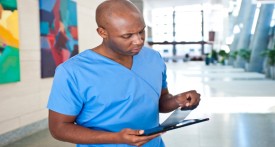“What you want are facts, not opinions… Who can have any opinion of any value as to whether the patient is better or worse, excepting the constant medical attendant or the really observing nurse?” - Florence Nightingale.
While famous for revolutionising the nursing profession during the Crimean War (1853–56), Florence Nightingale was also the first female member of the Royal Statistical Society and a pioneer in the use of data to improve patient care.
In Florence’s time, nurses had to manually check doctors’ records for data trends to create better care procedures. Unlike Florence, modern nurses and doctors can rely on real-time data from an ever-expanding array of electronic monitoring devices to help them better attend patients’ needs.
The Internet of Things (IoT) has created a new era of health monitoring devices – from fitness-tracking wristbands to sophisticated bedside heart monitors, pacemakers, and dialysis machines – that can share data instantaneously. This in turn allows for real-time analytics to improve patient care. The possibilities of these developments are extensive and ever-expanding.
More data enables better personal care
Nurses could track in real time a patient’s sleeping patterns, diet, blood pressure, cardio function, exercise regimes and more. Pairing these technologies with electronic patient records, high-quality monitoring apps, and mobile devices like the Lenovo ThinkPad 10 powered byIntel® Core™ processors creates the possibility for nurses to help patients anticipate and proactively avoid health problems.
Patients themselves could also be empowered to be more proactive with their health through real-time data and alerts. For example, a diabetic patient could receive reminders on their mobile phone to re-check their blood sugar when an app detects an unusual trend, or have recipes – based on their health profile, daily activities, and the food stored in their IoT-connected fridge – sent to their mobile phone.
Monitoring risk in clinical patients
This stream of data becomes even more important for patients in clinical care. Nurses could now use data to predict more serious problems before they emerge. For example, doctors could lower rates of gastrointestinal infection by recording bowel movements and automatically checking data for symptoms and trends suggesting risk of illness.
Similarly, data could help doctors lower mortality rates by combining real-time information with patient records, pharmacy data, and resource availability. A nurse in 2016 could check data against statistical models to indicate when interventions may be required. It’s estimated that a test rollout of a real-time data system in two hospitals in the UK saved nearly 800 lives in just one year.
More efficient processes and systems
Real-time data flows create the possibility for healthcare facilities to use resources more efficiently and maximise positive patient outcomes. Real-time data flows could help hospitals ensure information is always up to date, and administrators could identify any bottlenecks – such as too many patients in the emergency room, or patients who need to receive medication from the pharmacy before being discharged – so they can allocate staff appropriately.
The ability to track and analyse real-time data flows could also help hospitals anticipate resource requirements and place patients in the most appropriate wards. Beds could be opened or closed as needed, equipment and consumables tracked and allocated appropriately, and staff rostered or redeployed for best effect.
Florence Nightingale was right – facts are better than opinions. Real-time data feeds provide access to more facts than ever. It’s up to healthcare workers (and healthcare technology providers) to make sure they are using these facts to deliver better health outcomes for all patients.
Lenovo® ThinkPad® and ThinkCentre® products, powered by Intel® processors, are optimised for long, worry-free hours helping to deliver customised healthcare anywhere. Speak with a Lenovo specialist today to learn more.














